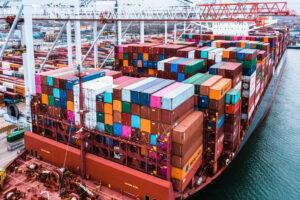The ongoing warehouse labor shortage is one of the biggest challenges facing the logistics industry today. Businesses must focus on mitigation efforts as demand surges and hiring rates struggle to keep up. Artificial intelligence (AI) in warehouses may provide a solution.
Staffing levels have steadily increased, but warehousing and storage employment in the U.S. dropped by 3,000 jobs between 2021 and 2022. An aging current workforce and declining birth rates suggest this trend will continue well into the future. Consequently, warehouses must start looking for ways to mitigate the labor shortage’s impact outside conventional hiring practices.
How AI in Warehouses Can Mitigate Labor Shortages
AI has gained increasing popularity as a way to accelerate and automate knowledge worker processes. However, even largely physical warehouse operations can benefit from this technology. Here’s how.
Automating Time-Consuming Tasks
Automation is the most straightforward benefit of AI in warehouses. Even though many processes are mostly physical, knowledge tasks like data entry, scheduling and inventory planning still take considerable time. AI can automate these data-heavy, repetitive jobs to give human employees more time to focus on others, letting facilities accomplish more despite low staffing levels.
AI can also analyze picking data, sales information and other process-related information to discover where inefficiencies lie and suggest improvements. Warehouses may need to place high-volume items in easier-to-reach locations or reorganize shelves to aid navigation, considering warehouse workers spend 80% of their time walking. AI can highlight areas to improve to enable higher productivity without additional hiring.
This automation and optimization leave organizations with more time in the workday to accomplish value-adding tasks. As a result, they can achieve the same productivity boosts as they would by hiring more staff but don’t have to rely on a volatile labor market.
Optimizing Hiring and Training
AI can also address the warehouse labor shortage by helping companies improve hiring and retention practices. Conventional approaches in this area often fall short, with just 6% of businesses getting the workers they need from staffing agencies despite 84% using at least two of these services. AI provides a better way forward.
Generative AI tools can create more appealing and accurate job descriptions and draft emails to prospective employees to boost applications. LinkedIn has already started testing a description-drafting AI and uses it to match candidates to jobs that fit them. Similar AI can scour the web for professionals with the ideal skills for a position traditional job searches may miss, including those who aren’t actively searching for a new position. As a result, warehouses can extend their reach to attract more new hires.
After potential hires apply, AI tools can prescreen their resumes to determine who may be the best fit for the company. Some businesses also use AI to identify early signs of burnout to intervene and prevent churn. Similarly, automated tools can streamline repetitive work to make day-to-day tasks more engaging, increasing retention. AI can also automate much of the data entry involved in hiring and onboarding to let new hires get started faster.
Improving Workforce Engagement
Warehousing organizations could also use AI to improve employee engagement. The same AI analytics that reveals where processes can be more efficient can highlight potentially unsafe workflows. Management could then make changes to reduce workplace injuries, boosting morale.
AI in the warehouse automates boring, repetitive tasks like data entry and invoicing, leaving humans with more engaging work, such as driving machinery or working with others to coordinate operations. Employees might also have smaller workloads overall, which helps them feel less stressed. Without these improvements, rising demand could lead to increased workloads, risks and stress for the workforce, hindering engagement and morale.
Boosting workforce engagement is a critical part of mitigating warehouse labor shortages. Businesses with highly engaged employees experience 43% less turnover and 18% more productivity than those with low engagement.
Responsible AI Usage in Warehouse Employment
These advantages make it clear that AI in the warehouse is a critical part of addressing the labor shortage. However, businesses must also be aware that AI presents risks like job displacement and inequality without careful implementation. Given these risks, companies should approach AI cautiously and thoughtfully.
While AI and automation help mitigate labor shortages, warehouses may fall into the other extreme and contribute to job loss as they automate more processes. Reskilling and upskilling are the solutions to this issue. Facilities implementing more AI and automation initiatives should also offer career development opportunities to equip workers with AI-related skills. That way, they can remain valuable employees in a more automated future.
It’s also important to recognize that AI is only as helpful as the data it analyzes. Poor-quality information will produce lackluster results, even with a reliable AI model, causing businesses worldwide to lose $12.9 million annually. Consequently, warehousing organizations must thoroughly clean, verify and organize their data before analyzing it to ensure accurate results.
Because AI requires such large data volumes, it may also introduce cybersecurity concerns. Warehouses must train all employees in best practices, restrict access permissions to sensitive data and use advanced, up-to-date security software to stay safe.
AI Could Be Essential in Addressing Warehouse Labor Shortages
The ongoing labor shortage is a significant obstacle but not an insurmountable one. Properly applying AI in warehouses could be the key to overcoming this challenge.
No single tool provides all the answers an organization needs to improve, but AI is one of the most powerful available today. Warehouse managers who understand how it can help them and use it carefully can mitigate and eventually resolve labor shortages.
Author Bio:
Emily Newton is the Editor-in-Chief of Revolutionized Magazine. She has over five years covering stories about warehousing, logistics and distribution.
- SEO Powered Content & PR Distribution. Get Amplified Today.
- PlatoAiStream. Web3 Data Intelligence. Knowledge Amplified. Access Here.
- Minting the Future w Adryenn Ashley. Access Here.
- Buy and Sell Shares in PRE-IPO Companies with PREIPO®. Access Here.
- Source: https://www.allthingssupplychain.com/can-ai-help-warehouses-reduce-the-impact-of-labor-shortages/?utm_source=rss&utm_medium=rss&utm_campaign=can-ai-help-warehouses-reduce-the-impact-of-labor-shortages
- :has
- :is
- :not
- :where
- $UP
- 000
- 2021
- 2022
- 9
- a
- About
- accelerate
- access
- accomplish
- accurate
- Achieve
- actively
- Additional
- address
- addressing
- advanced
- advantages
- agencies
- Aging
- AI
- Aid
- All
- already
- also
- an
- analytics
- analyze
- analyzes
- analyzing
- and
- Annually
- answers
- appealing
- applications
- Apply
- Applying
- approach
- approaches
- ARE
- AREA
- areas
- artificial
- artificial intelligence
- Artificial intelligence (AI)
- AS
- At
- automate
- Automated
- automates
- Automation
- available
- aware
- BE
- before
- benefit
- BEST
- best practices
- Better
- between
- Biggest
- boost
- boosting
- boosts
- Boring
- businesses
- but
- by
- CAN
- candidates
- Career
- careful
- carefully
- causing
- cautiously
- challenge
- challenges
- Changes
- clear
- Companies
- company
- Concerns
- Consequently
- considerable
- considering
- continue
- contribute
- conventional
- coordinate
- could
- covering
- create
- critical
- Current
- Cybersecurity
- data
- data entry
- day-to-day
- Declining
- Demand
- Despite
- Determine
- Development
- discover
- distribution
- Dont
- draft
- driving
- Early
- editor-in-chief
- efficient
- efforts
- emails
- Employee
- employees
- employment
- enable
- engaged
- engagement
- engaging
- ensure
- entry
- essential
- Even
- eventually
- experience
- extend
- extreme
- facilities
- facing
- Fall
- faster
- feel
- fit
- Focus
- For
- Forward
- from
- future
- Gartner
- get
- getting
- Give
- given
- Have
- help
- helpful
- helping
- helps
- higher
- Highlight
- highly
- hires
- Hiring
- How
- However
- HTTPS
- human
- Humans
- ideal
- Impact
- implementation
- implementing
- important
- improve
- improvements
- in
- Including
- increased
- increasing
- industry
- Inequality
- information
- initiatives
- Intelligence
- intervene
- into
- introduce
- inventory
- invoicing
- involved
- issue
- IT
- items
- Job
- Jobs
- jpg
- Keep
- Key
- knowledge
- labor
- labor market
- Lackluster
- large
- largely
- lead
- least
- Leave
- leaving
- less
- letting
- levels
- like
- locations
- logistics
- looking
- lose
- loss
- Low
- machinery
- magazine
- make
- management
- Managers
- many
- Market
- Match
- max-width
- May..
- might
- Mitigate
- mitigating
- mitigation
- model
- more
- more efficient
- most
- mostly
- much
- must
- Navigation
- Need
- needs
- New
- obstacle
- of
- offer
- often
- on
- Onboarding
- ONE
- ongoing
- only
- Operations
- opportunities
- optimization
- or
- organization
- organizations
- Other
- Others
- outside
- over
- overall
- part
- permissions
- physical
- Place
- planning
- plato
- Plato Data Intelligence
- PlatoData
- popularity
- position
- potential
- potentially
- powerful
- practices
- prevent
- processes
- produce
- productivity
- professionals
- properly
- prospective
- provide
- provides
- Rates
- reach
- recognize
- reduce
- reliable
- rely
- remain
- repetitive
- requires
- reskilling
- restrict
- result
- Results
- retention
- Reveals
- revolutionized
- rising
- risks
- s
- safe
- sales
- same
- scheduling
- searching
- security
- Security software
- sensitive
- Services
- she
- shelves
- Short
- shortage
- shortages
- should
- significant
- Signs
- similar
- Similarly
- single
- skills
- smaller
- Software
- solution
- Solutions
- some
- spend
- Staff
- staffing
- start
- started
- stay
- Still
- storage
- Stories
- straightforward
- streamline
- stress
- Struggle
- such
- suggest
- Surges
- Take
- tasks
- Technology
- Testing
- than
- that
- The
- The Future
- their
- Them
- then
- These
- they
- this
- thoroughly
- those
- though?
- time
- time-consuming
- to
- today
- tool
- tools
- traditional
- Train
- Trend
- turnover
- two
- u.s.
- understand
- up-to-date
- upskilling
- Usage
- use
- using
- Valuable
- verify
- volatile
- volumes
- walking
- Warehouse
- Warehouse Operations
- Warehousing
- Way..
- ways
- web
- WELL
- which
- WHO
- will
- with
- without
- Work
- worker
- workers
- workflows
- Workforce
- working
- Workplace
- worldwide
- would
- years
- zephyrnet











